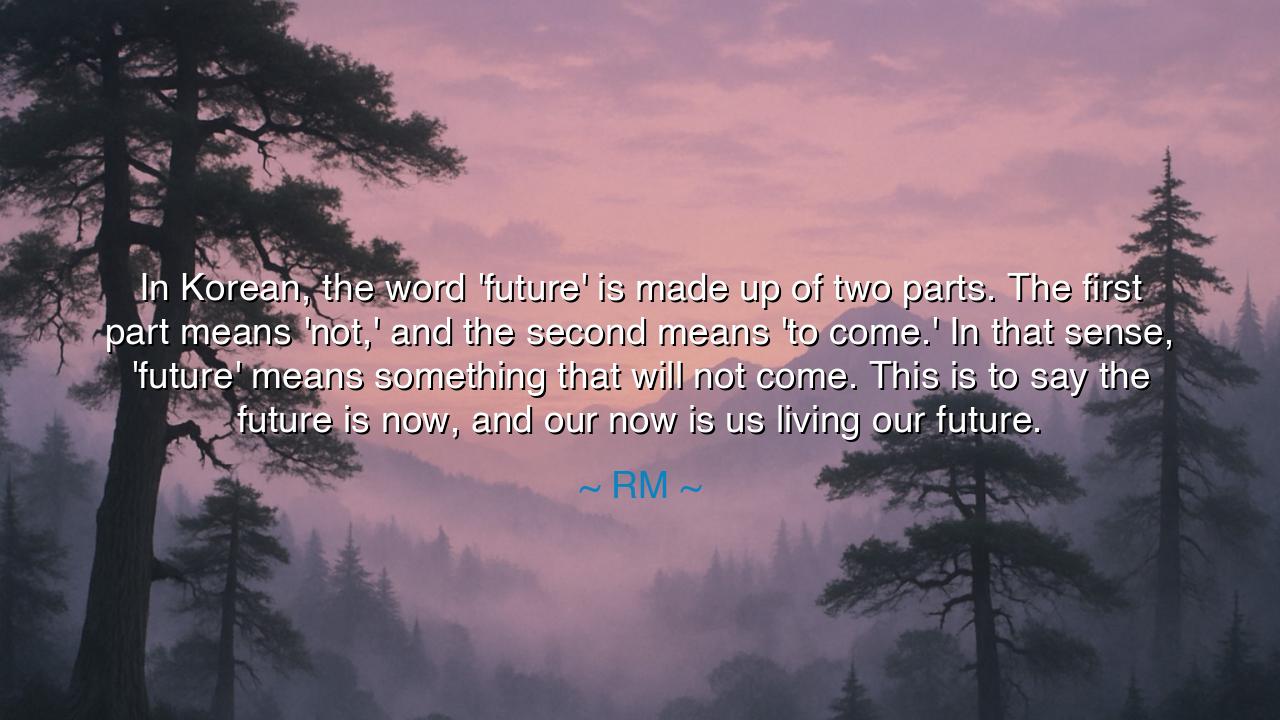
In Korean, the word 'future' is made up of two parts. The first
In Korean, the word 'future' is made up of two parts. The first part means 'not,' and the second means 'to come.' In that sense, 'future' means something that will not come. This is to say the future is now, and our now is us living our future.






On the Eternal Present and the Illusion of Tomorrow
When RM, the poet and philosopher of a modern generation, said, “In Korean, the word ‘future’ is made up of two parts. The first part means ‘not,’ and the second means ‘to come.’ In that sense, ‘future’ means something that will not come. This is to say the future is now, and our now is us living our future,” he spoke a truth that transcends language and time. Beneath the surface of linguistics, his words unfold a wisdom as ancient as the stars — the realization that the future is not a distant horizon to be reached, but a living flame burning in this very moment. His reflection reminds us that humanity’s greatest illusion has always been the belief that tomorrow is separate from today.
The word “future”, as he observes, carries within it a paradox — “not” and “to come.” In this paradox lies a profound teaching: that what we call the future is forever deferred, forever just beyond the touch of the hand. Each time we reach for it, it slips into the present, transforming what was to be into what is. The ancients would have called this the dance of impermanence — the truth that life is always unfolding in the now, that no moment exists except this one. To chase the future, therefore, is to chase the shadow of time; to awaken to the present is to grasp eternity.
RM’s insight echoes the wisdom of philosophers long past. The Buddha taught that “Do not dwell in the past, do not dream of the future, concentrate the mind on the present moment.” Likewise, the Stoic emperor Marcus Aurelius wrote, “Confine yourself to the present.” In their words, as in RM’s, there is no rejection of hope or ambition, but a call to awaken — to see that the seeds of all tomorrows are planted in the soil of today. When we act, love, or dream now, we are not preparing for the future; we are creating it. The future, therefore, is not “to come” — it is already here, woven into each heartbeat, each breath, each choice.
Consider the story of Leonardo da Vinci, who worked tirelessly on his inventions, sketches, and ideas that would not be realized until centuries after his death. To his contemporaries, he was a dreamer, forever building for a future that seemed unreachable. Yet Leonardo lived his “future” every day — for in his act of creation, he was already in communion with the destiny he imagined. The helicopters, bridges, and machines he drew were not predictions; they were manifestations of his present genius. So too, RM’s words teach us that those who wait for the future to arrive never find it — but those who live their vision now are already walking within it.
In saying, “the future is now, and our now is us living our future,” RM reminds us that time is not a road stretching ahead, but a circle ever turning upon itself. The child you once were still speaks through your laughter; the elder you will become already watches through your choices. Each act of kindness, each spark of courage, each word spoken in love — these are the bricks with which the future is built. To delay them is to delay life itself. The present moment is not a bridge to the future — it is the future made real, pulsing and alive within our hands.
There is also humility in his teaching. The future that “will not come” warns us against arrogance — against assuming that time will wait for our readiness. Many live as if tomorrow were promised, as if their purpose could begin “someday.” But the truth, ancient and unchanging, is that someday never arrives. Empires crumble waiting for the perfect hour; hearts grow old waiting for the right moment. The wise do not wait. They understand that the moment before them — fragile, fleeting, and imperfect — is enough. In embracing the now, they step into the flow of life itself.
The lesson, then, is clear and luminous: live your future now. Do not dream of becoming — be. Do not wait for courage — act. Do not imagine love — give it. Every breath is a seed of tomorrow, and every choice a shaping of eternity. To walk through life with this awareness is to stand awake while the rest of the world sleeps in dreams of “someday.” Let your present be your masterpiece, and your future will unfold as its natural reflection.
Thus, in the quiet depth of RM’s reflection lies the wisdom of the sages and the poets alike: the future is not a place we are going, but a state we are creating. It is not a promise written in time, but a pulse within us — constant, luminous, alive. To live with this understanding is to be free of fear and delay, to walk with purpose and peace. For when we awaken to the truth that the future is now, we finally begin to live the life we have long been waiting for.






AAdministratorAdministrator
Welcome, honored guests. Please leave a comment, we will respond soon